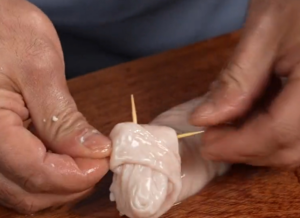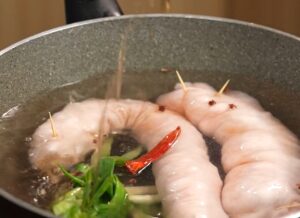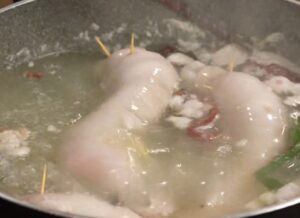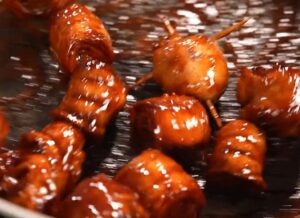 Nine-Turned Pork Intestines is a traditional Chinese delicacy that offers a delightful taste and is rich in nutrients. It features pork intestines as the main ingredient and undergoes a unique cooking process to achieve a satisfying combination of flavors, colors, and aromas. During the cooking process, Nine-Turned Pork Intestines requires multiple steps, including cleaning, cooking, and simmering, with each step requiring precise skills and timing to ensure the optimal texture and taste of the final dish.The history of Nine-Turned Pork Intestines can be traced back to ancient China when it was originally a gourmet dish served in the imperial court. Over time, it gradually became popular among the general public and evolved into a locally renowned specialty. The preparation of this dish demands certain techniques and patience, but it is precisely its complexity and uniqueness that have made Nine-Turned Pork Intestines a beloved favorite for many.Beyond its delicious taste, Nine-Turned Pork Intestines also offers abundant nutritional value. It contains protein, fat, dietary fiber, as well as various vitamins and minerals, providing the body with ample energy and nutrition. Furthermore, Nine-Turned Pork Intestines is believed to have additional health benefits such as promoting intestinal regularity, invigorating the body, and nourishing the blood.
Nine-Turned Pork Intestines is a traditional Chinese delicacy that offers a delightful taste and is rich in nutrients. It features pork intestines as the main ingredient and undergoes a unique cooking process to achieve a satisfying combination of flavors, colors, and aromas. During the cooking process, Nine-Turned Pork Intestines requires multiple steps, including cleaning, cooking, and simmering, with each step requiring precise skills and timing to ensure the optimal texture and taste of the final dish.The history of Nine-Turned Pork Intestines can be traced back to ancient China when it was originally a gourmet dish served in the imperial court. Over time, it gradually became popular among the general public and evolved into a locally renowned specialty. The preparation of this dish demands certain techniques and patience, but it is precisely its complexity and uniqueness that have made Nine-Turned Pork Intestines a beloved favorite for many.Beyond its delicious taste, Nine-Turned Pork Intestines also offers abundant nutritional value. It contains protein, fat, dietary fiber, as well as various vitamins and minerals, providing the body with ample energy and nutrition. Furthermore, Nine-Turned Pork Intestines is believed to have additional health benefits such as promoting intestinal regularity, invigorating the body, and nourishing the blood.
Ingredients for Nine-Turned Pork Intestines:
| Pork intestines | 600g |
| Cooking wine | 20g |
| Green onion | 20g |
| Ginger | 8g |
| Star anise | 3g |
| Sichuan Pepper | 3g |
| Cinnamon bark | 2g |
| Rock sugar | 20g |
| Soy sauce | 5g |
| White vinegar | 10g |
| Dried chilli | 8g |
| Pepper powder | 2g |
Step:
1.First, we need to prepare a piece of pork intestines. After removing the pork intestines, flip them inside out for easier cleaning and handling. Next, rinse the pork intestines thoroughly with water, making sure to clean both the inside and outside. Use running water to remove any dirt or impurities on the surface. During the cleaning process, pay attention to removing excess fat and oil from the inside of the pork intestines. This will make them healthier and more suitable for consumption. By carefully cleaning and handling the pork intestines, we can ensure their hygiene and quality for taste. Ensure the freshness of the ingredients and follow proper food handling and safety guidelines.

2.The key step in making Nine-Turned Pork Intestines is to layer the raw pork intestines together to shape them. Firstly, take an appropriate amount of raw pork intestines and layer them one by one, preferably three layers, but two layers can also work if necessary. The purpose of this step is to ensure that the pork intestines maintain their shape when cooked. After layering the pork intestines, secure them with toothpicks. Insert toothpicks at regular intervals to hold the layers together. This is because the pork intestines may shrink during cooking, and using toothpicks helps them maintain their shape. Once the toothpicks are secured, additional small holes can be pierced on the surface of the pork intestines to enhance the texture. These small holes allow the seasoning and broth to penetrate the interior of the pork intestines, resulting in a more uniform flavor. Following these steps completes the preparation of the Nine-Turned Pork Intestines. This method helps the pork intestines maintain their shape during cooking and adds variety to the texture.

3.Blanch the pork intestines in boiling water. Fill a pot with clear water and place the prepared Nine-Turned Pork Intestines in the pot. Add a small amount of cooking wine, green onions, and chili peppers. Cooking wine helps to remove any fishy odor, while green onions and chili peppers add aroma and flavor. Then, heat the pot over high heat for ten minutes. During this process, the pork intestines will be cooked and some of the fishy odor will be removed. After ten minutes, pour out the water from the pot. Rinse the pork intestines with cold water to remove any foam or impurities. This will make the pork intestines cleaner and improve their texture. Through the blanching process, we successfully eliminate the unpleasant odor of the pork intestines and maintain their hygiene and quality for taste.

4.Fill the pot with plenty of water and add the blanched Nine-Turned Pork Intestines. Next, add seasonings such as green onions, ginger slices, star anise, cinnamon bark, and Sichuan peppers. These seasonings will enhance the aroma and flavor of the pork intestines. Set the heat to high and wait for the water to boil, then reduce it to low heat for simmering. This ensures even heating and a gentle cooking process for the pork intestines. During the cooking process, carefully observe the condition of the pork intestines. If any bulges appear, use a toothpick to poke small holes. This allows the gas in the bulges to escape and helps the pork intestines cook evenly and absorb flavors. Depending on personal preference and desired texture, simmer for around forty minutes to an hour. Through the slow cooking process, the pork intestines will become tender, flavorful, and easy to chew. Pay attention to the cooking time and the state of the pork intestines to avoid overcooking and compromising the texture.

5.After cooking, remove the pork intestines from the pot, drain excess moisture, and cut them into sections. However, be careful to leave the toothpicks intact to maintain the stability and shape of the pork intestines. In the same pot, add approximately 20g of rock sugar, a small amount of water, and cooking oil. Set the heat to medium-low and stir-fry the sugar until it turns reddish-brown and large bubbles gradually become smaller. Then, add 10g of green onions and 10g of ginger and continue stir-frying to release their fragrance. Next, add 1 dried chili and Sichuan peppers, continuing to stir-fry briefly to infuse the ingredients with a spicy aroma. Place the cut sections of pork intestines in the pot and reduce the heat to low. Add 10g of cooking wine, 2g of pepper powder, 5g of soy sauce, and 10g of white vinegar to enhance the flavor. Continue stir-frying until the seasonings are evenly coated on the pork intestines, ensuring they are well-flavored.

6.Once the stir-frying is complete, remove the cooked Nine-Turned Pork Intestines from the pot and arrange them on a serving plate. Pay attention to the aesthetics of the presentation and feel free to be creative with plating according to personal preference. Before serving, remember to remove the toothpicks from the pork intestines to avoid any inconvenience or safety hazards while eating. Finally, pour the remaining sauce from the pot over the pork intestines on the plate to further enhance their moistness and flavor. Now, the Nine-Turned Pork Intestines have completed all the cooking steps and are ready to be enjoyed.

Tips:
1.Ensure that you purchase fresh pork intestines with no signs of damage or strange odors. Before handling them, carefully wash the pork intestines to remove any impurities.
2.To shape the Nine-Turned Pork Intestines, it is recommended to layer multiple pieces of raw pork intestines together. Typically, three layers work best, but if needed, two layers can also suffice. After securing them with toothpicks, make additional small holes on the pork intestines. This helps with shaping and flavor penetration.
Nine-Turned Pork Intestines is a classic Chinese dish known for its unique cooking technique. It primarily features pig intestines that are meticulously cleaned and cooked, combined with various seasonings and ingredients, resulting in a distinctive texture and flavor. The dish offers a delicious and tender mouthfeel, rich aroma, and requires specific skills and time to master. This Chinese delicacy is not only tantalizing but also provides a pleasurable cooking and dining experience. Each bite showcases the delicate texture of the pig intestines and the perfect harmony of flavors from the various seasonings. Every aspect of this dish seems to tell an ancient story, immersing people in its charm. Whether in the cooking process or the taste experience, Nine-Turned Pork Intestines exude irresistible allure that lingers in one’s memory.

